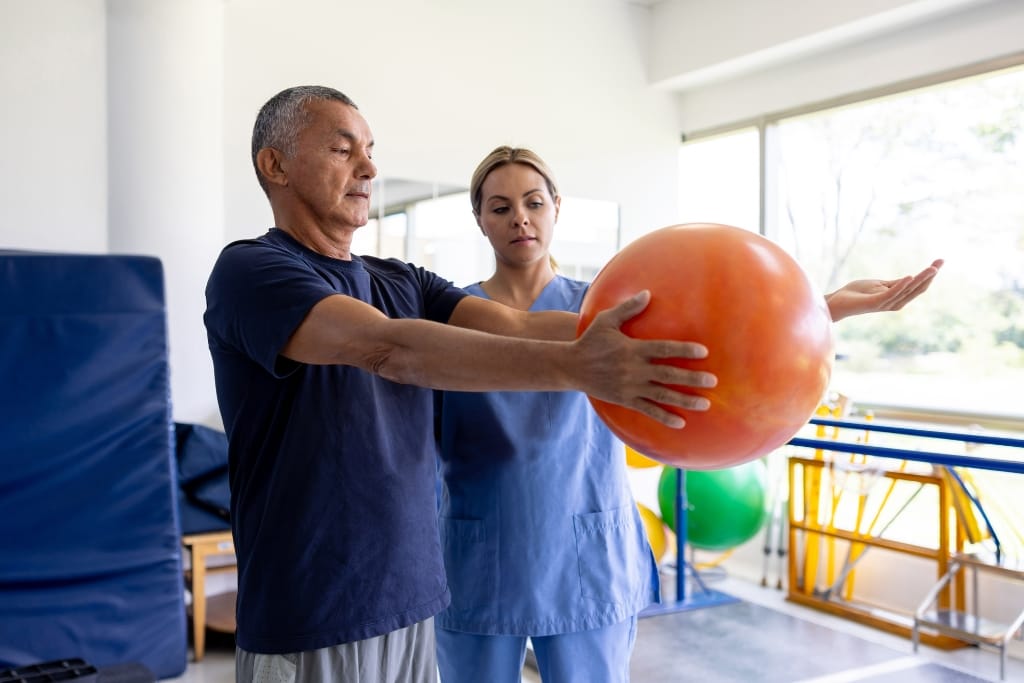Recovering from an injury, managing chronic pain, or improving mobility often requires a tailored approach to movement and strength.
Physical therapy plays a crucial role in helping individuals regain their independence and confidence through carefully designed exercises.
These exercises are not only effective in targeting specific areas of the body but also in fostering overall well-being.
By understanding the different types of exercises your therapist may guide you through, you'll be better equipped to achieve your recovery goals and enhance your quality of life.
Get ready to discover eight types of exercises that can make a significant difference in your rehabilitation journey.
1)) Stretching Techniques
Stretching techniques taught during physical therapy sessions play a crucial role in improving flexibility, reducing muscle tension, and enhancing overall mobility.
These techniques are often tailored to address the specific needs and conditions of each individual, ensuring that they target areas of discomfort or limited range of motion effectively.
By focusing on controlled movements and proper form, these stretches help to release stiffness, promote better circulation, and prevent injuries.
Physical therapists guide patients through these exercises methodically, empowering them with the tools needed to maintain progress long after the sessions are completed.
The guidance provided in these sessions not only supports recovery but also encourages long-term physical health and balance.
2)) Strength Training
Strength training plays a crucial role in physical therapy sessions, as it helps rebuild muscle strength, improve mobility, and restore functionality.
These exercises are carefully tailored to each individual's needs, focusing on specific muscle groups that require attention due to injury, stress, or weakness.
By engaging in structured strength training under the guidance of a skilled therapist, patients can gradually enhance their stability and endurance.
These sessions often involve the use of resistance bands, free weights, or bodyweight exercises to promote controlled and safe movements.
Over time, consistent practice not only facilitates recovery but also helps prevent future injuries, enabling individuals to regain confidence and independence in their daily lives.
3)) Balance Exercises
Balance exercises play a pivotal role during physical therapy sessions, focusing on improving stability, posture, and coordination.
These exercises are carefully tailored to challenge the body's natural equilibrium, helping individuals regain control over their movements.
Techniques such as standing on one leg, walking heel-to-toe, or using balance boards are often utilized to strengthen core muscles and improve proprioception.
These targeted practices are particularly beneficial for individuals recovering from injuries, surgeries, or conditions that affect mobility, as they help rebuild confidence, reduce the risk of falls, and enhance overall functionality.
Through consistent effort and guided support, patients experience measurable progress that directly impacts their ability to perform everyday tasks with increased ease and reliability.
4)) Range Of Motion Movements
Range of motion movements play a vital role in the recovery process during physical therapy.
These exercises are specifically designed to improve flexibility, ease joint stiffness, and restore mobility that may have been affected by injury, surgery, or chronic conditions.
By guiding patients through controlled and targeted movements, therapists help strengthen muscles, promote circulation, and prevent long-term complications such as muscle atrophy or joint immobility.
Each session gradually introduces motions that challenge the affected areas while ensuring patient comfort and safety.
Over time, these exercises help individuals regain confidence in their physical abilities, enabling them to perform daily activities with greater freedom and reduced pain.
5)) Core Stabilization
Core stabilization exercises play a crucial role in physical therapy sessions, focusing on strengthening the muscles that support the spine, pelvis, and overall posture.
These exercises are designed to improve balance, enhance coordination, and provide a solid foundation for movement.
By targeting key muscle groups such as the abdominal, back, and pelvic muscles, they help to prevent injuries and alleviate existing pain.
Patients are guided through carefully structured routines that challenge their stability and control, gradually building endurance and strength over time.
Regular practice of core stabilization not only supports recovery efforts but also enhances overall functionality, enabling individuals to carry out daily tasks with improved efficiency and confidence.
6)) Aerobic Conditioning
Aerobic conditioning plays a crucial role in physical therapy sessions, emphasizing the enhancement of cardiovascular health and endurance.
Such exercises are tailored to improve the body's ability to transport and use oxygen efficiently, directly benefiting heart and lung function.
By engaging in activities such as walking, cycling, or swimming, patients can build stamina and reduce fatigue over time.
These routines are carefully designed to match an individual's current fitness level and therapeutic goals, ensuring progress in a safe and controlled manner.
Beyond physical improvements, aerobic conditioning can boost mood and mental clarity, providing a holistic approach to recovery and overall well-being.
7)) Posture Correction Drills
During physical therapy sessions, posture correction drills play a crucial role in fostering proper alignment and improving musculoskeletal health.
These exercises are tailored to target imbalances, strengthen the core, and support the spine, which helps alleviate pain and prevent future injuries.
Therapists guide individuals in recognizing poor posture habits and provide practical strategies to adjust their daily movements.
Whether sitting, standing, or engaging in complex motions, these drills encourage healthy positioning that supports long-term stability and functionality.
Consistent practice not only promotes better posture but also enhances overall confidence and comfort in everyday life.
8)) Functional Mobility Work
Physical therapy sessions often focus on building functional mobility skills that are essential for performing everyday tasks with greater ease and efficiency.
These sessions emphasize movements that mimic real-life activities, allowing individuals to strengthen specific muscle groups and improve coordination.
By engaging in targeted exercises, patients can work on enhancing their balance, flexibility, and strength, which are all critical for preventing injuries and maintaining independence.
Therapists guide individuals through personalized routines that address their unique needs, ensuring progress and promoting a smoother return to daily activities.
The tools and techniques learned in these sessions often have long-lasting impacts, empowering individuals to move more confidently and reduce discomfort over time.
Conclusion
Physical therapy is more than just a treatment; it is a path toward reclaiming quality of life and fostering long-term well-being.
Addressing the root causes of physical challenges not only alleviates pain but also equips individuals with the knowledge and tools to sustain their progress.
From improving mobility to building strength and confidence, physical therapy empowers people to regain control over their lives while preventing future injuries.
With a personalized approach rooted in care and expertise, it serves as a bridge to recovery, restoring hope and enabling individuals to thrive in their daily endeavors.
This holistic approach reinforces that recovery is not just about healing the body but also about nurturing the mind and spirit.
Download Our Free E-book!








